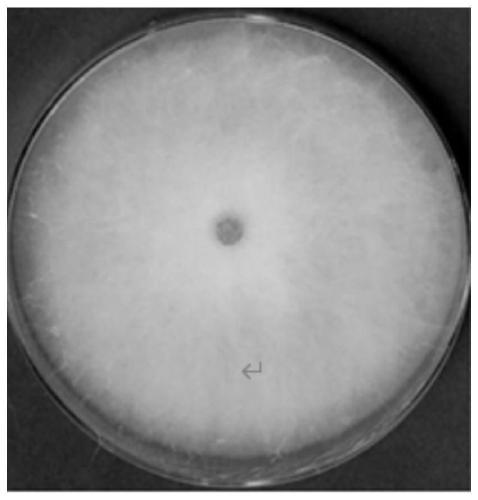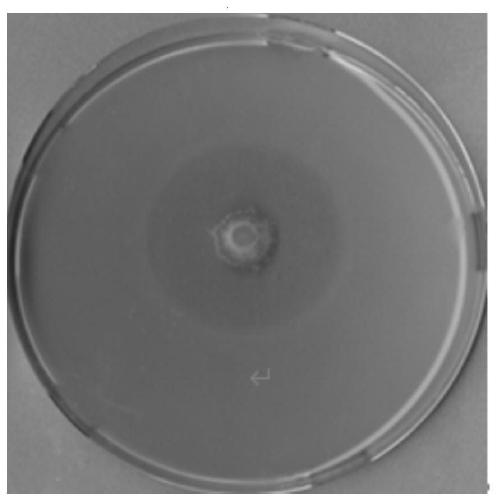Bacillus velezensis and application thereof in degrading deoxynivalenol (DON)
A technology of bacillus and microbial strains, applied in the direction of application, bacteria, fungicides, etc., can solve the problems of wheat ear grain shrinkage, carcinogenesis, and quality decline, and achieve good properties and stability, high control effect, and operability strong effect
- Summary
- Abstract
- Description
- Claims
- Application Information
AI Technical Summary
Problems solved by technology
Method used
Image
Examples
Embodiment 1
[0024] Embodiment 1: Isolation and identification of bacteria
[0025] 1.1 Isolation of bacteria
[0026] (1) In the ultra-clean workbench, place the newly collected diseased ears of wheat and corn in 100 mL of sterile water, shake and rinse for 30 minutes, and suspend them sufficiently to make a bacterial suspension.
[0027] (2) After gradiently diluting the bacterial suspension with sterile water, take 100uL from each concentration of bacterial suspension dilution and spread it on the LB medium plate, place it at 30°C for 48 hours, and then pick it out on the plate Streak and purify single colonies with different shapes, sizes, and colors on LB plates, and number them.
[0028] (3) Take the purified strains of different numbers and culture them in LB liquid medium at 30°C and 180rpm for 24 hours, then take 2mL of fermentation liquid and mix them into 15mL of PDA medium, pour them on the plate, and inoculate cereals in the center of the plate after solidification Fusarium ...
Embodiment 2
[0036] Embodiment 2: the antagonism (co-cultivation method) of Velez bacillus TP to Fusarium graminearum
[0037] (1) After the purified TP strain was cultured in LB liquid medium at 30°C and 180rpm for 48 hours, 1mL of fermentation broth was evenly mixed into 15mL of PDA medium, poured onto a plate, solidified, and set aside.
[0038] (2) Use a hole puncher with a diameter of 0.5 cm to punch holes at the edge of the cultured pathogenic fungus Fusarium graminearum F18 colony to obtain bacterial flakes, and set aside.
[0039] (3) Use a sterile pick to pick the above-mentioned F18 bacterial slices into the center of the PDA plate in (1), and set the PDA plate inoculated with Fusarium graminearum F18 bacterial slices as the control group at the same time, and cultivate them at 30°C for 4-6 Day, observe the growth colony speed and colony radius of F18. Three replicates were set up for each, and the results are shown in Table 1.
[0040] Table 1 The inhibitory effect of TP on Fu...
Embodiment 3
[0044] Embodiment 3: TP fermented liquid detects the prevention and cure effect of potted corn ear rot
[0045] (1) Inoculate TP into LB culture medium, cultivate at 30°C and 180rpm for 72h, and obtain fermentation broth, with a biomass of 1.20×10 10 cfu / mL; adjust the bacterial concentration to 10 with tap water 9 CFU / mL, spare;
[0046] (2) The corn pot experiment was completed in the East Campus of Shandong Academy of Sciences from summer to autumn of 2018. The experiment used plastic flowerpots with a diameter of 33cm and a depth of 28cm. The soil was collected from the field cultivation layer, sieved and mixed with an appropriate amount of organic fertilizer. Each pot was filled with 14kg of soil. After watering, the Zhengdan 958 corn seeds were manually sown on June 20 , covered with 1.5cm thick fine soil. 21 days after emergence, 2 seedlings were set in each pot, watered quantitatively during the whole growth period, and managed normally. Set 4 treatments: CK contro...
PUM
 Login to View More
Login to View More Abstract
Description
Claims
Application Information
 Login to View More
Login to View More - R&D
- Intellectual Property
- Life Sciences
- Materials
- Tech Scout
- Unparalleled Data Quality
- Higher Quality Content
- 60% Fewer Hallucinations
Browse by: Latest US Patents, China's latest patents, Technical Efficacy Thesaurus, Application Domain, Technology Topic, Popular Technical Reports.
© 2025 PatSnap. All rights reserved.Legal|Privacy policy|Modern Slavery Act Transparency Statement|Sitemap|About US| Contact US: help@patsnap.com



